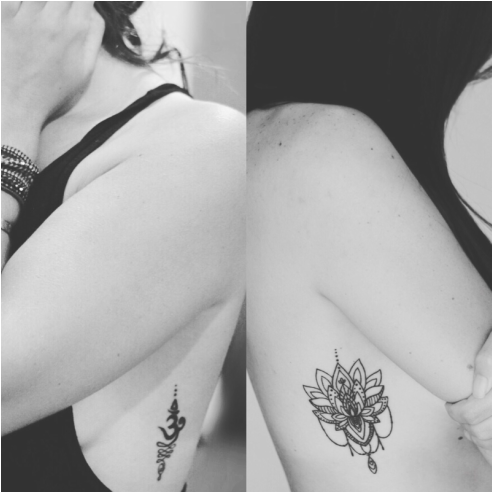Tatted in Thailand
Bamboo or Machine?
When I arrived in Thailand, I was a blank canvas- my skin as uninked as the day I was born. I knew this wouldn't last very long, as I'd always had a mind to get a tattoo abroad. Before I even got to Thailand, I knew
the country and my experiences there would change my life. I also knew that I'd want to mark that time with a permanent souvenir. Collecting passport stamps and postcards is fun and all, but tattoos...they're like scars. They tell a story.
I'd heard that Thailand was known for their bamboo method of tattooing. In particular, Thai monks use it for the traditional sak yant tattoos- an increasingly popular choice among foreigners. Thinking it'd be an experience to use a tattooing method not widely practiced in my own part of the world, my research commenced. After consulting a few sources, one of these ironically being a UK based bamboo tattoo artist, a few points stuck out to my tattoo virgin eyes: 1. They hurt less 2. They heal faster.
The general concept is this- ink is skillfully tapped into the skin using the sharpened end of a bamboo stick or metal rod. It is said to puncture not tear the skin, resulting in a quicker healing process. Staying out of the sun and water are typical post-treatment requirements for any tattoo, but per my reading and firsthand experience, these things were a non-issue.
For 10 months I took note of the many tattoo shops scattered in and around Bangkok and the southern islands. It was about 3 months in, while on the island of Koh Phi Phi, that I noticed the place I ultimately decided on. It had an energy that drew me in from the unpaved walking street it lined. It was casual, the music was loud, and the Thai guys were a vision straight out of the 70's with long hair and tattoos all over. This is who I wanted doing the job. So 8 months later, I was back on the island and ready to make irreversible decisions.
The tattoo shop on Phi Phi. That's me laid out on the table for all to see.
Early on in the day I swung by the shop with a drawing that I'd put together. I'd used a combination of images that I liked to create the design (I can kind of draw?) They assured me they'd customize it further and told me to come back in a few hours to approve. After a few small tweaks, I was pleased with the outcome. Not sure what to expect and surprisingly at ease, I lay on my side on a table, for all of Koh Phi Phi's foot traffic to see. I then proceeded to let a non-English speaking Thai man stab me with a stick for about 45 minutes.
Everyone has different pain thresholds, and search results yield a wide range of experiences when it comes to just how much people think tattoos hurt. I can only speak for myself. While it wasn't what I would call an enjoyable feeling, it was a lot less painful than I expected. Just a bit uncomfortable and...pin pricky. Yes, pin pricky. When he'd finished, he gave me a tiny round container of some ointment to protect it with. He didn't cover it. Didn't tell me to stay out of the sun. Didn't tell me not swim. In fact, I'm pretty sure he would've thrown me in the ocean right then and there if he could, because I asked about ten times if he was absolutely positive swimming was allowed.
The lack of aftercare instructions could easily be chalked up to the Thai way- which often involves cutting corners. After all, a Western machine tattooist did later insist that the same kind of care should be taken for both types of tattoos. Whether right or wrong, I can't say for sure. What I can safely say is that my bamboo tattoo never peeled, I did go swimming very soon after, and I made absolutely zero efforts to protect it. A year later, all is well.
People interested in the sak yant tattoo, as performed by a monk in a temple (we're talking Angelina Jolie style) should go here and get informed. The blogger Expert Vagabond shares his firsthand experience. It's by far the most authentic tattooing option in Thailand, and despite widely expressed sanitary concerns about the reusage of the tool and the ink, I'm 99% sure you'd survive getting tattooed by them. Many before you already have. But my mama told me sharing needles is bad, and who am I to tell her she's wrong.
The final product.
Let us fast forward a year and it's nearly time for me to leave Thailand. I'd been contemplating a second tattoo from the moment I got the first (it really is an addiction, they say.) I'd had my eye on a mandala lotus design from Day 1, but wasn't brave enough to get something bigger that required intricate details for my first tattoo. I decided now was the time to go for it. I reached out to several of the recommended names in Bangkok- including Stay Cold Tattoo and Common Ground. The former was going out of town, but CG was immediately responsive and explained their process for booking, designing, and payment in a very clear and professional way. Given I had very little time before I had to leave the country, they were super accommodating. I was invited in ASAP to discuss designs and put down a deposit.
Common Ground Tattoo Bangkok
Vibes, vibes, vibes. I can't stress enough how heavily I rely on the vibes a place gives off. Once again, I'd struck tattoo shop gold. Common Ground is a newly renovated Chinese shophouse right off of Saphan Taskin BTS. Colorful, full of Asian knick-knacks and filled with the intoxicating scent of incense, I was instantly at ease. What can I say- the place just felt good.
Formerly Six Fathoms Deep, the shop is run by a South African named Dillon and his Thai staff. This was the ideal scenario- I could clearly explicate what I wanted to a native English speaker, and he was then able to relay it to the Thais. This setup maintained the authentic experience I was looking for without any risk of miscommunication (highly undesirable when permanent ink is involved.) I ultimately wanted my artist to be Thai, and Dillon was able to close the language gap perfectly.
My first visit we sat down and discussed the vision. I'll admit, aside from a few photos I wasn't super clear about what I wanted. I had a vision in my head, but couldn't quite translate it to paper or words. The very next morning they sent me a design via Facebook. It was lovely, but there was something missing. It wasn't until I saw the draft that I was able to put my finger on the changes I wanted. I sketched something out, sent it back, and a few hours later they'd nailed it. "Let's tattoo it tonight!" he'd said. And we did.
So there I was, on my side once again- but this time in the comfort of a private room. I took a few swigs of a Leo (beer) and braced myself for what I could only assume would be a more painful version of what I'd done before. Much to my surprise, it felt no different than the bamboo. It took about an hour, and the result was beautiful. Thin, delicate lines and the lotus mandala I'd envisioned.
Having been tattooed by both methods, I can't say I actually prefer one over the other. The pain factor was equivalent as far as I could tell. The machine tat did peel a bit and I cleaned and treated it daily with baby soap and an antibiotic cream. I also stayed out of the water as instructed. In my opinion, there's a noticeable difference in the precision of my bamboo vs machine tattoo- the machine one having much cleaner lines. All in all- if you're interested in getting ink in Thailand, choose the option that best fits the scenario. If you want a unique cultural experience, go for the bamboo. If you want the cleanest lines, the safest route and don't mind a bit of healing time- opt for the machine.
Curious to hear if anyone's experiences have significantly differed from mine- feel free to comment below!
Happy tatting!







